Optimization of Sample Preparation processes of Bone Material for Raman Spectroscopy†
Abstract
Raman spectroscopy has recently been investigated for use in the calculation of postmortem interval from skeletal material. The fluorescence generated by samples, which affects the interpretation of Raman data, is a major limitation. This study compares the effectiveness of two sample preparation techniques, chemical bleaching and scraping, in the reduction of fluorescence from bone samples during testing with Raman spectroscopy. Visual assessment of Raman spectra obtained at 1064 nm excitation following the preparation protocols indicates an overall reduction in fluorescence. Results demonstrate that scraping is more effective at resolving fluorescence than chemical bleaching. The scraping of skeletonized remains prior to Raman analysis is a less destructive method and allows for the preservation of a bone sample in a state closest to its original form, which is beneficial in forensic investigations. It is recommended that bone scraping supersedes chemical bleaching as the preferred method for sample preparation prior to Raman spectroscopy.




